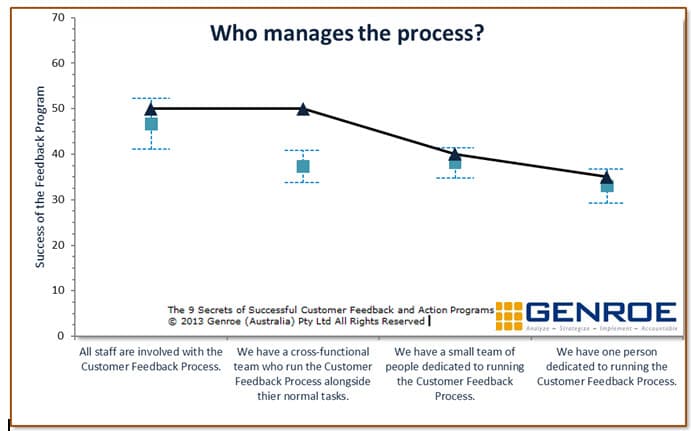I’m sure you’ve heard that you need to engage all staff in the customer feedback process. So have we, and we recommend to all of our clients to do just that but our recent research report Research: 6 Key Drivers of Successful Customer Feedback Programs has demonstrated just how important this is to overall success.
As you can see from the chart below, organisations that get everyone involved in the customer feedback and action process are significantly more successful than organisations that focus the task on one or a small number of people.
We have always said that customer feedback is not Marketing or Strategy or Customer Service’s job, it is everyone’s job and this supports that belief.
It makes good sense to have customer feedback champions and “Subject Matter Experts” to provide education and mentoring to the rest of the organisation, to maximise your success you need to ensure that all staff are part of the customer feedback process and engaged in its success.


How Do You Do It?
Strategize how you are going to get everyone in the organisation engaged in the customer feedback process and make sure that it is not seen as any one person, or team’s, role to action customer feedback.
So I know you’re convinced but how do you set about engaging the entire organization? Firstly as noted above, you need to think and plan how you are going to do it. This aspect of change management should be part of your customer feedback implementation.
Then, from a practical perspective here are a few approaches that our clients have used to engage the broad organisation in the process.
Brand The Process
If you can brand the overall process within your organisation so people see the process in lots of places it can really help engage your employees.

In their Net Promoter program roll-out, the Wolters Kluwer Asia Pacific organisation created a name and branding for the program. Called Converse, the brand became the symbol by which everyone came to know about Net Promoter in the organization.
Janine Scott from Wolters Kluwer suggests that you try lots of different ways to communicate with employees. Don’t just use a communications medium. Different people take in information in different ways so try lots of different approaches so that everyone can receive the information in the way that suits them the best.
In addition, the company created a simple video for broad distribution that gave the story behind the Converse program.
Be Transparent and Distribute Feedback Widely
We have talked before about the need to be as transparent as possible with the customer feedback information that you are collecting. In fact two of our customers, nib health funds and MYOB, both say that feedback transparency is critical to success.
Not only should you be transparent with the feedback but you should share it widely. Put the feedback in as many places as possible: on your intranet, on display boards in your executive suites, contact centres, branches and lunch room. Make the information easy for anyone with an interest to access.
Engaged is More Than Informed
If you have done all of the above, congratulations, you’re ahead of most organizations. You’re not finished however; in fact the most important part is still to come.
Just distributing information is not enough; you have to get your employees actively engaged. If all you ever do is tell them what is happening without ever letting them get involved in changing the business they will be keen for a while and then lose interest as time goes on.
How to Get Employees Involved
The secret here is to get them active in analysing the feedback and making changes to the business. There are lots of ways to do that but one really simple way is to put a customer feedback root cause analysis item on regular meeting agendas.
I quite like using the Five Why’s Root Cause Analysis Approach because it is quick and doesn’t take much training to implement.
If your team has a huddle each morning then perhaps you can take one piece of negative customer feedback from the past week and spend 15 minutes on a Five Why’s analysis. If you have a weekly staff meeting then maybe you do the same thing.
Now you have a suspected root cause to work on, see which of your team members wants to flesh it out and have a go and identifying a solution. Have them report back at the next meeting (in a week) with what they have found. Support them in the implementation of a fix.
Once you start down this track you are unfreezing the organisation and starting the process of making changes every day.
At First Focus on Small Changes
Sure there are plenty of big problems in your company, just like every other company out there, but don’t focus on them first. Use your Five Whys workshops to find some small, easy to solve root causes, and focus on making some change, any change, to demonstrate to yourself and your employees that change can and will come from the process.
It’s like starting a fire. First you use your match just to get some paper and twigs to catch alight. Then you use the twigs to set fire to the larger logs and before long you have a nice warm fire. If you use your match and attempt to alight the big logs, major chances are you’ll fail and everyone feels cold, and bad. Start where it’s easy.
The Good News is That It’s a Two Way Street
Fortunately if you do get it right, a good customer feedback and action program is a two way street. As employees see their actions having an effect they will become more engaged themselves.
As the quote, again from Wolters Kluwer Asia Pacific, indicates:
Employees can see it and they can pick up the phone and talk to the customer, and employee engagement is going up because of that. It’s making people’s lives a bit more meaningful because they are seeing directly from these customer comments and scores that ‘hey, we make a difference.’
Jessica Hobson, Director of Marketing and Product Management





